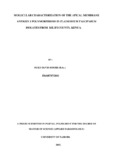| dc.description.abstract | Of the five Plasmodium species that cause human malaria, Plasmodium falciparum is the leading cause of morbidity and death with about 300 million medical cases every year. Erythrocyte invasion is an essential process in the life cycle of the malaria parasite hence parasite survival in the human host needs successful invasion of merozoites into uninfected red blood cells. Several parasite proteins such as apical membrane antigen (AMA1) can accomplish similar roles in the invasion process. Plasmodium parasites have developed a number of distinct evasion responses such as varying sequence and maintaining functions employed by merozoite surface proteins (MSPs) and AMA1, reduced antigenicity by reticulocyte binding homologue 5 (RH5) and redundancy in multi-gene families depicted by erythrocyte binding like antigens (EBAs) and RHs .The interaction between P. falciparum AMA1 and another parasite protein called rhoptry neck protein 2 (RON2) is essential for tight junction formation, which commits the merozoite for invasion. Currently there is no vaccine effective against the blood-stages of P. falciparum though RTS, S is the most advanced candidate malaria vaccine but it is only partially protective .The aim of this study was to understand the genetic diversity of AMA1 within P. falciparum isolates. A total of 241 human blood samples were obtained from Junju location, Kilifi County. The AMA1 gene was successfully amplified by polymerase chain reaction (PCR) for 37 samples. Following successful sequence analysis, 14 haplotypes were identified. Analysis of the cluster one loop (C1-L) codon regions encompassing position 187-207 revealed polymorphisms ranging between 2-4 different amino acids, with position 197 being the most polymorphic while comparing to the reference AMA1 sequence. Analysis of AMA1 deoxyribonucleic acid (DNA) sequence using the Tajima’s D statistic test for neutrality showed that the identified single nucleotide polymorphisms were not under selection and mutations occurring in this gene are neutral. These observed polymorphisms are in agreement with previous studies on genetic diversity of AMA1 hence making it a possible vaccine candidate. | en_US |



